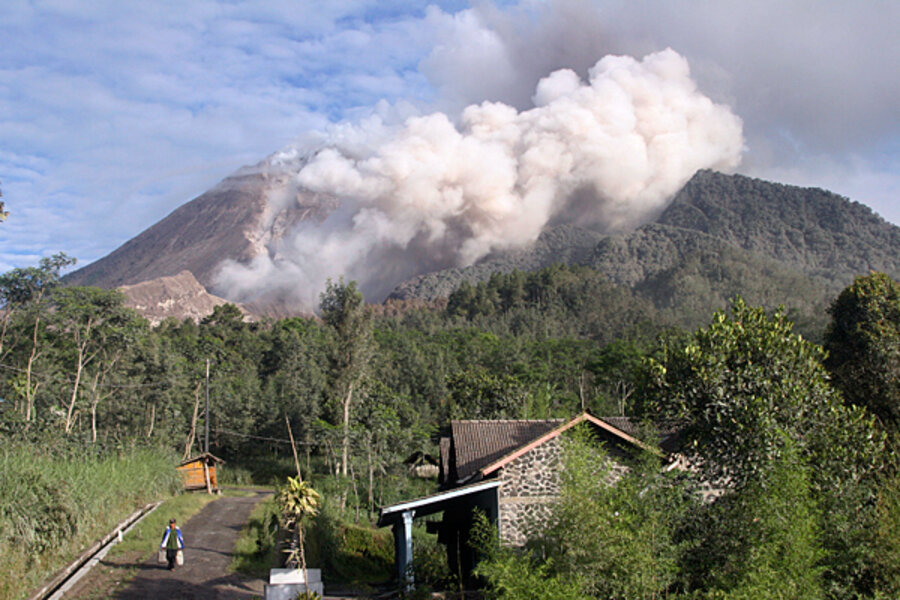Indonesia's Mt. Merapi shelters overflow with restless evacuees, flights canceled
Loading...
| Mount Merapi, Indonesia
Scores of women and children sit on thin reed mats in Wonokerto evacuation shelter, one of dozens set up at the base of Indonesia’s most active volcano. Groups of college students from around Java move around the room urging them to get up and sing, play games, or scribble in coloring books – anything to keep the disaster victims active.
"We're concerned about their morale because they become bored easily," said Rani Sitimaharani, a student volunteer from the Yogyakarta Care Alliance. "We also try to help the children forget about what happened with the eruption, to help them with the trauma."
But many of the disaster victims prefer to keep their eyes on a television news program discussing the volcano that has put them in the auditorium of the school-turned-evacuation-center, forced international airlines to cancel flights to nearby airports Tuesday, and hindered aid work.
One week after Mount Merapi unleashed its first blast of searing gas and debris, evacuation centers have reached capacity. Ongoing eruptions have sent more people fleeing the volcano’s slopes, raising concern among rescue workers about morale and next steps. The death toll from the volcano eruptions is now at 38 people, and the tally of evacuees has been raised to nearly 70,000.
Villagers here say they’re bored of sitting still. Mainly, they say they are worried about their homes. Despite the danger of another eruption, and the possibility of inhaling hazardous gas and ash, many villagers, mainly men, return to their farms during the day to check on the crops and livestock they depend on for their incomes. A few women have started joining them recently, looking for something to keep busy.
They bring reports back with them. “I heard that my house has been destroyed,” said Parmi, one evacuee. “I’m afraid to go back because there is nothing.”
Volunteers and aid workers worry about morale at the camps, which are quickly becoming hot and overcrowded. Adequate supplies of clean water and sanitation are also problems. Workers say some camps have only five toilets for every 1,000 people.
At Wonokerto, soldiers hand out medicine to tackle minor ailments they worry could sweep through packed shelters and become big problems. The government called in the military Saturday to keep people from going back up the mountain, but villagers say they’ve grown up on the volcano and understand its dangers.
They say they can tell when an eruption is coming, but few were prepared for the deafening crack that accompanied the latest major eruption Monday, the third major explosion amid multiple explosions in the past week.
Scientists say the force of that blast helped relieve built-up pressure inside the volcano’s crater. But they also say Merapi could continue to belch hot gas and ash for weeks, stretching refugees' patience and the government’s ability to provide aid.
The plumes of smoke and ash have also forced at least two airlines to cancel flights. The Associated Press reported that Malaysian budget airline AirAsia and Singapore's SilkAir suspended several international flights to Yogyakarta and Solo, both within 20 miles of the crater and popular hopping points to the famed 9th century Borobudur temples.
Both airlines reported they expected to resume operations soon.
Meanwhile, another set of rescue workers complain that it has taken days for aid to reach the remote Mentawai Islands, where a tsunami sparked by a 7.7-magnitude earthquake slammed into the sparsely populated island chain last Monday, killing more than 430 people and leaving 15,000 homeless.
President Susilo Bambang Yudhoyono has assured the National Disaster Management Agency that he would provide the money and equipment to help the country recover from dual natural disasters that hit the country within 24 hours of each other.
Some politicians are discussing the idea of permanently relocating people who live in proven danger zones, such as coastal areas. But the idea has gained little traction, particularly since it was tried before on Mount Merapi.
Indonesia sits on the Pacific Ring of Fire, an area prone to frequent earthquakes and volcanic activity. Officials say there are currently 21 other active volcanoes around the archipelago.
After Merapi’s eruption last Monday, scientists noted an uptick in volcanic activity in several locations around the country. Mount Anak Krakatau located between the islands of Java and Sumatra has released nearly 100 short blasts each day over the past week, and officials continue to monitor another volcano in north Sumatra that came to life in August after lying dormant for 400 years.





